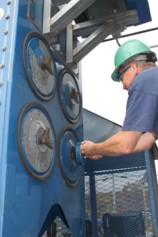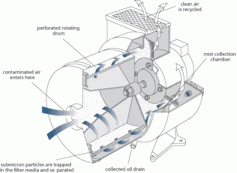ISSUE: 3 OCTOBER/2012
Macy Industries, Inc., has valued employees who have been working with us to service and manufacture components and dust collectors for over 30 years. One of those special employees includes, Roger Leavitt, has worked with MACY INDUSTRIES, INC., for over 20 years. During this time he had installed and familiarized himself with duct work. Roger has worked with dust collectors for 20 years specializing in the installation and service of dust and mist collectors. MACY INDUSTRIES, INC., does not have a lot of dust collectors, so Roger spends a majority of his time servicing over 300 dust collectors throughout New England.
Why is Dust Collection Important?
 All dust is bad. All businesses need dust collectors because it is very important to haveTurn1-Dust Collection-Roger Leavitt clean air flow. All dust is bad. Fine particles from manufacturing and processing can enter your lungs. This can cause damage and over time will form scar tissue. Many people suffer from allergies and are very sensitive to dust. To prevent dust from hurting your home, business, or employees a dust collection system can help. You can control IAQ (indoor air quality) by frequently changing your filters and cleaning the dust collection system. This is a main component to Roger’s job. We consider Roger to have a green job because he protects people’s allergies, sensitive’s and lungs from hazardous dust material. How does a dust collector work? The dusty air flows into the system and gets cycled through the filters where it is cleaned. It is very important to change your filters so they do not get clogged. When the filter is not changed the velocity of the system is decreased and causes more mist and dust in the air, potentially harming clients and employees and affecting the quality of your products.
All dust is bad. All businesses need dust collectors because it is very important to haveTurn1-Dust Collection-Roger Leavitt clean air flow. All dust is bad. Fine particles from manufacturing and processing can enter your lungs. This can cause damage and over time will form scar tissue. Many people suffer from allergies and are very sensitive to dust. To prevent dust from hurting your home, business, or employees a dust collection system can help. You can control IAQ (indoor air quality) by frequently changing your filters and cleaning the dust collection system. This is a main component to Roger’s job. We consider Roger to have a green job because he protects people’s allergies, sensitive’s and lungs from hazardous dust material. How does a dust collector work? The dusty air flows into the system and gets cycled through the filters where it is cleaned. It is very important to change your filters so they do not get clogged. When the filter is not changed the velocity of the system is decreased and causes more mist and dust in the air, potentially harming clients and employees and affecting the quality of your products.
Types of Dust Collection
Mist verses Dust Collectors. There are two types of collectors: Mist and Dust. One collector can have up to four different filters. There is a wire mesh filter for large dust particle and there are other layers for finer dust. Mist collector internal view-dust collection-Issue3
 A mist collector acts as a vacuum that sucks the particles from the air into the system. Mist collectors should be located right next to machine or work areas to vacuum up minuscule dust particles. Roger changes more mist collectors because when a company such as General Electric works with many metals around the clock, the machinery gives off a lot of dust and particles. For example when GE cuts titanium, the hardest metal to penetrate, they must cut it by layer thus emitting a lot of particles into the air. For dust collectors there are two categories: small and large. Small dust collectors are primarily used for point of use, similar to a mist collector. A large dust collector is located outside the facility and includes duct work. It can run through the building or on the roof routing the dirty air out of the system, before cleaning it and putting the purified air back into the system. Most collectors have a downflow design, which reverses the direction of airflow, taking advantage of gravity and the airflow direction, forcing dislodged dust to fall directly into the collector hopper, minimizing non-treated air from re-entering the recycled air. Another thing that sets large dust collectors apart from small dust collectors is that they can self clean. When a large collector’s gauge reads high it tells the machine and person reading the gauge that it is full of dust. Then the unit will literally shake the dust off the filter. Large collectors can clean themselves to a point and then Roger has to go in and perform a maintenance and cleaning of the filters. Mist and small dust collections can only be cleaned by hand. Dust collectors also have HEPA filters; they clean the air but do not remove any smells.
A mist collector acts as a vacuum that sucks the particles from the air into the system. Mist collectors should be located right next to machine or work areas to vacuum up minuscule dust particles. Roger changes more mist collectors because when a company such as General Electric works with many metals around the clock, the machinery gives off a lot of dust and particles. For example when GE cuts titanium, the hardest metal to penetrate, they must cut it by layer thus emitting a lot of particles into the air. For dust collectors there are two categories: small and large. Small dust collectors are primarily used for point of use, similar to a mist collector. A large dust collector is located outside the facility and includes duct work. It can run through the building or on the roof routing the dirty air out of the system, before cleaning it and putting the purified air back into the system. Most collectors have a downflow design, which reverses the direction of airflow, taking advantage of gravity and the airflow direction, forcing dislodged dust to fall directly into the collector hopper, minimizing non-treated air from re-entering the recycled air. Another thing that sets large dust collectors apart from small dust collectors is that they can self clean. When a large collector’s gauge reads high it tells the machine and person reading the gauge that it is full of dust. Then the unit will literally shake the dust off the filter. Large collectors can clean themselves to a point and then Roger has to go in and perform a maintenance and cleaning of the filters. Mist and small dust collections can only be cleaned by hand. Dust collectors also have HEPA filters; they clean the air but do not remove any smells.
Roger’s Routine
Air quality and safety. Dust can be harmful to our health so Roger must take precautions when cleaning the systems. To protect himself he must wear a mask, respirator, glasses and a hat. Roger wears different levels of protection depending on the danger level of the job he is doing. He uses his discretion and experience to determine how much protection to is required. Roger has a daily routine, which he begins by using his service manual which provides all the information he needs on changing filters. He typically changes two filters per day. General Electric is his main customer so every day he checks in at the plant. Roger receives a work order and he goes through reports on individual collectors. He follows a form when changing the systems; he compares the performance on the system to how it performed in the past. New filters perform the best. Most dust collectors have a gauge which tells Roger the difference in pressure from the clean and dirty side. When the gauge is red, that means it is time to change the filter.
Have a need for a dust collection system or filter change out program?
MACY INDUSTRIES, INC., is here to help! Our staff of engineers can help with the on-site evaluation, design and manufacturing of your custom system that will meet the needs and demands of your facility. If you already have a dust collection system running let Roger help you maintain your collector for optimal performance.

